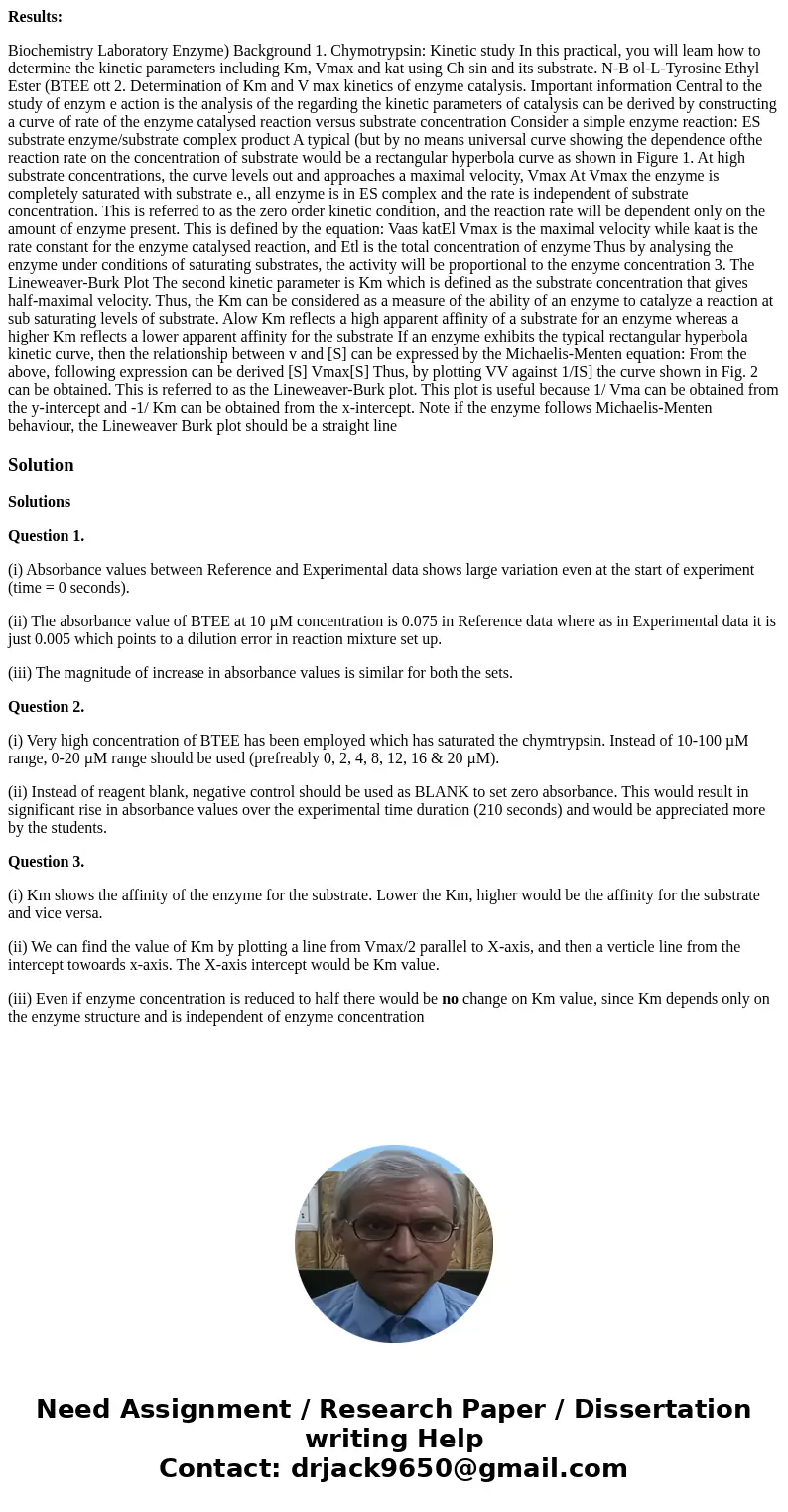Results Biochemistry Laboratory Enzyme Background 1 Chymotry
Results:
Biochemistry Laboratory Enzyme) Background 1. Chymotrypsin: Kinetic study In this practical, you will leam how to determine the kinetic parameters including Km, Vmax and kat using Ch sin and its substrate. N-B ol-L-Tyrosine Ethyl Ester (BTEE ott 2. Determination of Km and V max kinetics of enzyme catalysis. Important information Central to the study of enzym e action is the analysis of the regarding the kinetic parameters of catalysis can be derived by constructing a curve of rate of the enzyme catalysed reaction versus substrate concentration Consider a simple enzyme reaction: ES substrate enzyme/substrate complex product A typical (but by no means universal curve showing the dependence ofthe reaction rate on the concentration of substrate would be a rectangular hyperbola curve as shown in Figure 1. At high substrate concentrations, the curve levels out and approaches a maximal velocity, Vmax At Vmax the enzyme is completely saturated with substrate e., all enzyme is in ES complex and the rate is independent of substrate concentration. This is referred to as the zero order kinetic condition, and the reaction rate will be dependent only on the amount of enzyme present. This is defined by the equation: Vaas katEl Vmax is the maximal velocity while kaat is the rate constant for the enzyme catalysed reaction, and Etl is the total concentration of enzyme Thus by analysing the enzyme under conditions of saturating substrates, the activity will be proportional to the enzyme concentration 3. The Lineweaver-Burk Plot The second kinetic parameter is Km which is defined as the substrate concentration that gives half-maximal velocity. Thus, the Km can be considered as a measure of the ability of an enzyme to catalyze a reaction at sub saturating levels of substrate. Alow Km reflects a high apparent affinity of a substrate for an enzyme whereas a higher Km reflects a lower apparent affinity for the substrate If an enzyme exhibits the typical rectangular hyperbola kinetic curve, then the relationship between v and [S] can be expressed by the Michaelis-Menten equation: From the above, following expression can be derived [S] Vmax[S] Thus, by plotting VV against 1/IS] the curve shown in Fig. 2 can be obtained. This is referred to as the Lineweaver-Burk plot. This plot is useful because 1/ Vma can be obtained from the y-intercept and -1/ Km can be obtained from the x-intercept. Note if the enzyme follows Michaelis-Menten behaviour, the Lineweaver Burk plot should be a straight lineSolution
Solutions
Question 1.
(i) Absorbance values between Reference and Experimental data shows large variation even at the start of experiment (time = 0 seconds).
(ii) The absorbance value of BTEE at 10 µM concentration is 0.075 in Reference data where as in Experimental data it is just 0.005 which points to a dilution error in reaction mixture set up.
(iii) The magnitude of increase in absorbance values is similar for both the sets.
Question 2.
(i) Very high concentration of BTEE has been employed which has saturated the chymtrypsin. Instead of 10-100 µM range, 0-20 µM range should be used (prefreably 0, 2, 4, 8, 12, 16 & 20 µM).
(ii) Instead of reagent blank, negative control should be used as BLANK to set zero absorbance. This would result in significant rise in absorbance values over the experimental time duration (210 seconds) and would be appreciated more by the students.
Question 3.
(i) Km shows the affinity of the enzyme for the substrate. Lower the Km, higher would be the affinity for the substrate and vice versa.
(ii) We can find the value of Km by plotting a line from Vmax/2 parallel to X-axis, and then a verticle line from the intercept towoards x-axis. The X-axis intercept would be Km value.
(iii) Even if enzyme concentration is reduced to half there would be no change on Km value, since Km depends only on the enzyme structure and is independent of enzyme concentration

 Homework Sourse
Homework Sourse